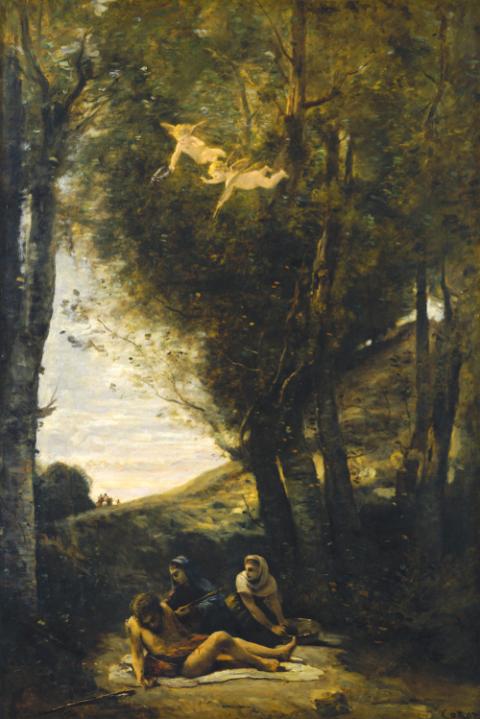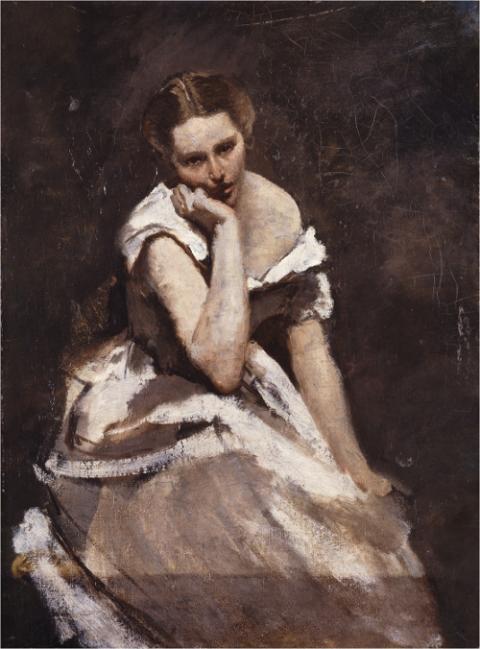
"Diana and Actaeon (Diana Surprised in Her Bath)" by Jean-Baptiste-Camille Corot, 1836, from the Robert Lehman Collection of the Metropolitan Museum of Art in New York (Metropolitan Museum of Art)
Writing of one of Jean-Baptiste-Camille Corot's nudes, a French journalist noted that the work was Corot's response to critics who said he painted "nothing but trees, because he doesn't know how to paint people." The latter added that Corot's painting "leaves something to be desired in terms of cleanliness: in the brown tones of certain parts of this beautiful body, one discerns a certain scurviness that remains most unpleasant to behold." That muddiness is a surprise, the critic continued, "for there is plenty of water in Monsieur Corot's landscapes with which to bathe."
Corot (1796-1875) was and is much better known for moody landscapes, within which dabs of white paint flicker like candlelight from amid deep green trees and undergrowth. Once one gets to know the artist's oeuvre, his works become easy to spot from across a room, and there is a pretty good chance of seeing a Corot canvas in most major or mid-sized museums in the country. When one considers Corot's lesser-known body of figures, as the National Gallery of Art's exhibition "Corot: Women" (through Dec. 31) does, one finds the artist flirting with a modern and self-conscious way of acknowledging the male gaze all but inherent in model painting, even as Corot remained of his time and still clung to some of the traditional and stylized ways of painting the female nude.
Among the nearly 50 canvases spread over four rooms at the Washington gallery, Corot's 1836 painting "Diana and Actaeon (Diana is Surprised in Her Bath)," from the collection of the Metropolitan Museum of Art, stands out for its monumentality. There is so much going on in the work, which contains seven figures amid a lush and elaborate landscape, that finding and tracking the hunter Actaeon can be like trying to locate Waldo. In the central part of the composition, a nude woman lowers herself from a vine into a pool of water, seemingly oblivious to the goddess Diana, who is covering herself with a pink cloth. In Diana's shadow, another woman crouches and hides her nakedness as best as she can, while two others look at the goddess, who points emphatically at a small Actaeon in the distance.
Those who know the mythological story which Corot references know that Actaeon, who has begun sprouting horns, is already doomed. Diana condemns the hunter, who accidentally stumbled upon the goddess bathing, to the awful fate of becoming a deer and having his own dogs hunt and kill him. The narrative elements all appear in Corot's painting, including the dogs who enter from the right side of the canvas, but Corot's choreography of the scene is extremely inventive. Actaeon appears so far in the distance that he couldn't possibly, within the logic of the painting, have gotten much of a peek at Diana, who has, in fact, already turned away from him. In so doing, however, she gives viewers of the painting a lot more than a passing view of her nude body. For his unwitting glance, Actaeon is sentenced to death, but the painting's audience may walk away unscathed.

"Saint Sebastian Succored by the Holy Women" by Jean-Baptiste-Camille Corot, 1874, from the Timken Collection (Courtesy of National Gallery of Art, Washington)
"Think about what would happen to you the viewer. You're right there. She can spin around and see you," Mary Morton, head of the National Gallery of Art's French paintings department and curator of the exhibit, told NCR. "It's about men looking at the nude. It's also about mortals and gods, but it's really about this area of female privacy and potency protected from male presence."
It's hard to have anything but sympathy for this accidental voyeur, whose punishment is certainly cruel and unusual, but the powerful stand that the painting takes against men assuming the right to leer at — or assault — women's bodies is extremely timely today.
Where previous painters almost inevitably objectified the nude models whom they painted and many had reputations of mixing business with pleasure, Corot's nude women appeared to have generally impressed the artist for their individuality and inner thoughts, rather than conformity to a stylized type. As the exhibition catalog notes, in some works Corot did his best impression of breaking down the fourth theater wall by including an easel to demonstrate, self-consciously, that the model was being painted. And Corot had a reputation for respecting models' privacy and treating them well.
Many of the women also make strong eye contact with the viewer, as does the model in a low cut top depicted in "Young Woman in a Pink Skirt" (circa 1845-50), from the Clark Art Institute in Williamstown, Massachusetts. The palette and the mood are considerably more muted in "Melancholy" (circa 1860), from Copenhagen's Ny Carlsberg Glyptotek, but the woman here too addresses the viewer boldly. Other models hold instruments, flowers, or have been interrupted while reading, all nods to stylized types, but even when Corot works within those traditional categories, his paintings tease out psychological rather than superficial portraits of the women.
Corot, who was Catholic, told a friend in August 1826 that all he wanted to do in life was to paint landscapes. "This firm resolve will stop me forming any serious attachments. That is to say, I shall not get married," he stated, and he appears to have kept his word. He may have developed his impressive knowledge of fashion materials, which surfaces in the clothed models, while spending time in his mother's successful hat shop, which also employed his father. But the degree to which Corot was religious, a question that is relevant to one painting in the exhibit, is more complicated to answer.
Advertisement
Before bed, Corot was said to have read Thomas à Kempis' devotional book The Imitation of Christ. German Jewish art critic Julius Meier-Graefe called Corot "devout" and suggested he regularly attended Mass, but added, "Although a good Christian, he was not a bad Pagan Greek," records Roger Kimball in the New Criterion.
"He was known for being an observant Catholic, and did paint religious works," said David Ogawa, assistant professor of art history at Union College in New York and author of a chapter in the exhibition catalog. Corot's first major commission was a baptism of Christ for Paris' Saint-Nicolas-du-Chardonnet Church, and Corot painted other versions in the French towns of Rosny and Ville d'Avray.
The National Gallery exhibit includes a circa 1850-60 painting of St. Sebastian, from the Musée des Beaux Arts de Lyon, who is nude save for a loincloth. Installed near the painting of Diana, this saint's hands are bound above his head in front of a tree. A landscape in the distance unfolds beneath dramatic light, perhaps twilight, but although no arrows have yet appeared, viewers know how this story will end. Corot also painted Sebastian in canvases that appear at the Louvre and Baltimore's Walters Art Museum, but this version is noteworthy for depicting a nude man.
"St. Sebastian is the cover that artists use to paint the male nude. From Renaissance times on, you couldn't portray that particular subject without showing the body pierced by arrows," Morton said. "My interest is that it's very much an individual. See his moustache? This is a naked man in the pose of St. Sebastian, and I just think it's beautiful."

"Melancholy" by Jean-Baptiste-Camille Corot, circa 1860, from the Ny Carlsberg Glyptotek in Copenhagen (Courtesy of National Gallery of Art, Washington)
Ogawa agreed with Morton that the specific details of the facial features and the "immediacy of the painted quality" suggest that Corot based the work on a particular model. "In most respects, his religious painting is pretty traditional," he said. "The St. Sebastian in the current exhibition is unique, in my view, because of its emphasis on the saint's body rather than the narrative."
Corot painted other religious subjects that range from monks reading or playing instruments, to a "Christ in the Garden of Olives," which Sotheby's sold a few months ago for $112,500. The Met owns a "Hagar in the Wilderness" (1835) and "The Burning of Sodom" (1843 and 1857), and the Louvre's collection includes an early work on Chartres Cathedral (1830). When Philadelphia's La Salle University put up dozens of works for auction earlier this year in a controversial decision, the lot included Corot's circa 1844-45 "Jesus and St. John."
The sense of individuality that Corot achieved in the nudes also carried over to the religious paintings, according to Ogawa, who thinks that Corot's pivot away from traditional means of depicting biblical scenes didn't mean that he was eschewing the religious altogether.
"Corot was pursuing modern forms of religious painting — immediacy, presence and expressive painting were his goals," he said. "In his case, this did not mean 'secular' in the sense of being less religious as much as it meant creating holy images through his unique, visual language as a modern painter."
Morton thinks that Corot considered the identity of Sebastian in the work less important than the chance to paint the male nude. Corot also addressed the subject within a broader landscape, as in the National Gallery's 1874 Corot painting "St. Sebastian Succored by the Holy Women," in which the three human figures occupy less than 10 percent of the canvas. Two putti above are also very small compared to the vast landscape.
In the portrait of the saint, which is included in the exhibit, Corot brings the man to the forefront rather than squirreling him away within a landscape. That, to Morton is significant.
"I think he's using the Bible as source material as opposed to trying to ignite religious fervor in his viewers," she said. "I think that is part of the secularization that is happening at this time. Only the academics are still painting scenes from the Bible."
[Menachem Wecker is a freelance reporter in Washington, D.C.]








